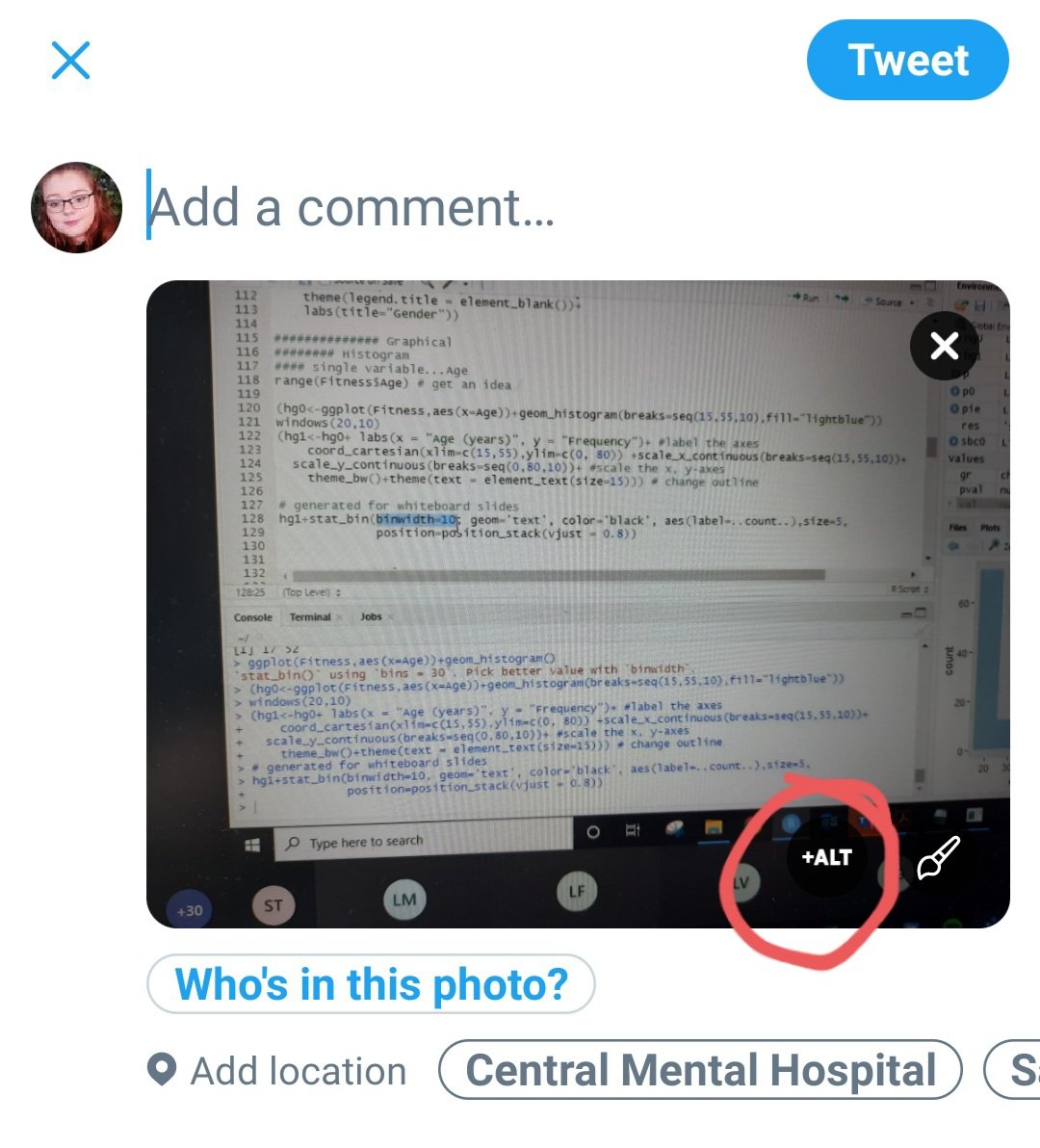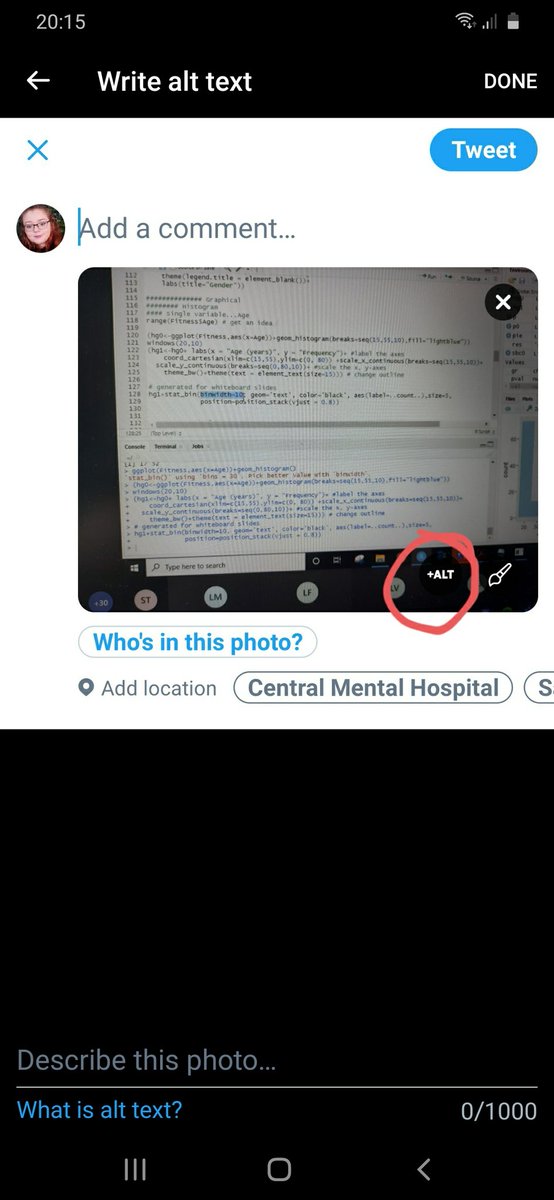Let& #39;s start with twitter since that& #39;s the platform we are on!
You can do several different types of posts on twitter:
- feed posts (w/ images, infographics, links, gifs or videos)
- livestreams
- polls
You can do several different types of posts on twitter:
- feed posts (w/ images, infographics, links, gifs or videos)
- livestreams
- polls
So I will be going more into graphics, infographics and posters tomorrow especially around design and contrast but when we talk about posting these images, we are referring to alt text.
Alt text (which I defined earlier) is extremely important as it is the only way that screen-readers can interpret images. But what& #39;s even more important is that the alt text you write a meaningful description of the image.
But what is meaningful? How do you decide what is important to describe as what is not? It may sound silly but focus on what the point of the image is. Why this graphic/gif/picture etc...? What is happening in it? Are there people, are the people relevant to the description?
If they are, what do they look like? Who are they (is this important?)? Is the date/place/event important?
Always ensure that you are giving a plain language description with good spelling and grammar!
Always ensure that you are giving a plain language description with good spelling and grammar!
If it is a poster or an infographic then your alt text needs to include a text version of the information given. If there is too much text you can do this by including a text file or non-editable google doc of this information.
If you& #39;d like to learn more about writing alt text in different situations then the WebAIM alt text guidelines are good! [web page link] https://webaim.org/techniques/alttext/">https://webaim.org/technique...
So how do you go about adding alt text to your post? When you load an image, a little black +ALT button will appear on the image (image 1). If you press this, then your view will change to a write alt text page which is the image with a blank text box at the bottom (image 2).
I forgot to say earlier that it is also a good idea to say the type of image you are using. Is it a gif/picture/screenshot/meme/diagram/etc...?
Next topic is language in tweets! General good practices are to optimize readability by using proper spelling & grammar. This is not always possible, there are a limited number of characters in a tweet but the main thing is not overuse uppercase as this can be difficult to read.
If you want to maximize understanding (as is generally important in science communication) you should minimise extended words (eg)Thhhiiiss or exchanging numbers for letters (eg) w0rd
Also not very legible is the alternating upper & lowercase (eg) ThIs Is DiFfIcUlT tO rEaD
Also not very legible is the alternating upper & lowercase (eg) ThIs Is DiFfIcUlT tO rEaD
Emojis (everyone hates when I bring this up).. emojis are little images and each one has a text description (e.g.)  https://abs.twimg.com/emoji/v2/... draggable="false" alt="😶" title="Mundloses Gesicht" aria-label="Emoji: Mundloses Gesicht"> is "face without a mouth".
https://abs.twimg.com/emoji/v2/... draggable="false" alt="😶" title="Mundloses Gesicht" aria-label="Emoji: Mundloses Gesicht"> is "face without a mouth".
That is fine on it& #39;s own but if people have used that emoji three or four times, it can start to get annoying..
That is fine on it& #39;s own but if people have used that emoji three or four times, it can start to get annoying..
The way emojis can really affect understanding through is when people put the & #39;clapping hands emoji& #39; ( https://abs.twimg.com/emoji/v2/... draggable="false" alt="👏" title="Applaus-Zeichen" aria-label="Emoji: Applaus-Zeichen">) between every word for emphasis.
https://abs.twimg.com/emoji/v2/... draggable="false" alt="👏" title="Applaus-Zeichen" aria-label="Emoji: Applaus-Zeichen">) between every word for emphasis.
This causes your tweet to lose all meaning for screen-readers as the words & #39;clapping hands emoji& #39; is said between every single word.
This causes your tweet to lose all meaning for screen-readers as the words & #39;clapping hands emoji& #39; is said between every single word.
If you can, use shortened links! Tiny url & Bitly are examples of websites for this!
You should also specify where the link is going so people can decide if they want to click it. You can describe this in the text "this is a video" or you could place [video] before the link.
You should also specify where the link is going so people can decide if they want to click it. You can describe this in the text "this is a video" or you could place [video] before the link.
I& #39;ve already mentioned using CamelCase in posts - #ScienceIsForEveryone
CamelCase makes hashtags comprehensible for screen-readers, as well as making them easier to read for everyone else!
CamelCase makes hashtags comprehensible for screen-readers, as well as making them easier to read for everyone else!
If you are posting videos then please include close captions. There are many different free/cheap apps & websites that you can use (e.g.) Inshot, Autocap (both have free options), Subtitle Horse (website) and Clipomatic (iOS only - $5) but you can also use many other softwares.
Some of these apps can auto generate the captions & some need to be manually imputed. Another way of captioning videos is using YouTube studio which is free.
The most important point I can say about captions is that if you are using auto generated, you NEED to edit for accuracy.
The most important point I can say about captions is that if you are using auto generated, you NEED to edit for accuracy.
You can use live streams on twitter but be aware that you need to connect your own third-party captioning generator. This needs to be synced to twitter before you start if you want to do an accessible live stream.

 Read on Twitter
Read on Twitter



